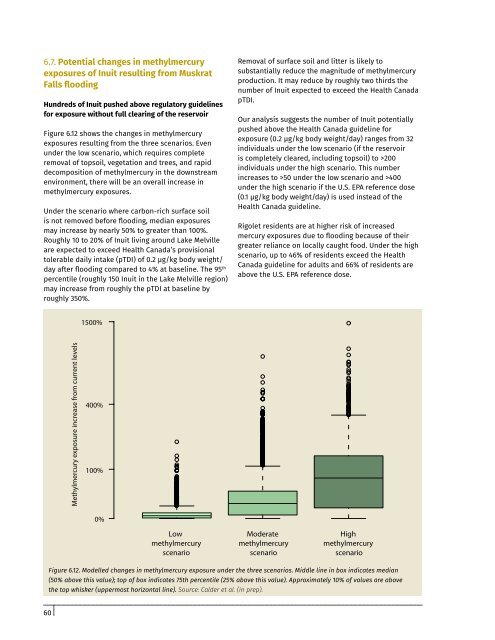Lake Melville
1rw7Mns
1rw7Mns
You also want an ePaper? Increase the reach of your titles
YUMPU automatically turns print PDFs into web optimized ePapers that Google loves.
6.7. Potential changes in methylmercury<br />
exposures of Inuit resulting from Muskrat<br />
Falls flooding<br />
Hundreds of Inuit pushed above regulatory guidelines<br />
for exposure without full clearing of the reservoir<br />
Figure 6.12 shows the changes in methylmercury<br />
exposures resulting from the three scenarios. Even<br />
under the low scenario, which requires complete<br />
removal of topsoil, vegetation and trees, and rapid<br />
decomposition of methylmercury in the downstream<br />
environment, there will be an overall increase in<br />
methylmercury exposures.<br />
Under the scenario where carbon-rich surface soil<br />
is not removed before flooding, median exposures<br />
may increase by nearly 50% to greater than 100%.<br />
Roughly 10 to 20% of Inuit living around <strong>Lake</strong> <strong>Melville</strong><br />
are expected to exceed Health Canada’s provisional<br />
tolerable daily intake (pTDI) of 0.2 µg/kg body weight/<br />
day after flooding compared to 4% at baseline. The 95 th<br />
percentile (roughly 150 Inuit in the <strong>Lake</strong> <strong>Melville</strong> region)<br />
may increase from roughly the pTDI at baseline by<br />
roughly 350%.<br />
Removal of surface soil and litter is likely to<br />
substantially reduce the magnitude of methylmercury<br />
production. It may reduce by roughly two thirds the<br />
number of Inuit expected to exceed the Health Canada<br />
pTDI.<br />
Our analysis suggests the number of Inuit potentially<br />
pushed above the Health Canada guideline for<br />
exposure (0.2 μg/kg body weight/day) ranges from 32<br />
individuals under the low scenario (if the reservoir<br />
is completely cleared, including topsoil) to >200<br />
individuals under the high scenario. This number<br />
increases to >50 under the low scenario and >400<br />
under the high scenario if the U.S. EPA reference dose<br />
(0.1 μg/kg body weight/day) is used instead of the<br />
Health Canada guideline.<br />
Rigolet residents are at higher risk of increased<br />
mercury exposures due to flooding because of their<br />
greater reliance on locally caught food. Under the high<br />
scenario, up to 46% of residents exceed the Health<br />
Canada guideline for adults and 66% of residents are<br />
above the U.S. EPA reference dose.<br />
1500%<br />
Methylmercury exposure increase from current levels<br />
400%<br />
100%<br />
0%<br />
Low<br />
methylmercury<br />
scenario<br />
Moderate<br />
methylmercury<br />
scenario<br />
High<br />
methylmercury<br />
scenario<br />
Figure 6.12. Modelled changes in methylmercury exposure under the three scenarios. Middle line in box indicates median<br />
(50% above this value); top of box indicates 75th percentile (25% above this value). Approximately 10% of values are above<br />
the top whisker (uppermost horizontal line). Source: Calder et al. (in prep).<br />
60


